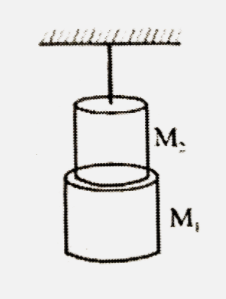The length of a metal wire is when the tension in it is and when the tension becomes . Find the natural length of wire.
To find the natural length of the wire, we can follow the steps outlined below:
1. Define Variables:
Let the natural length of the wire be denoted as L. The lengths of the wire under different tensions are given as l1 when the tension is F1 and l2 when the tension is F2.
2. Calculate Stress and Strain for the First Case:
- Stress (σ1) when the tension is F1:
σ1=F1A
- Strain (ϵ1) for the first case:
ϵ1=l1−LL
3. Express Young's Modulus for the First Case:
- Young's Modulus (Y) is defined as the ratio of stress to strain:
Y=σ1ϵ1=F1Al1−LL=F1⋅LA⋅(l1−L)
- Let this be Equation (1).
4. Calculate Stress and Strain for the Second Case:
- Stress (σ2) when the tension is F2:
σ2=F2A
- Strain (ϵ2) for the second case:
ϵ2=l2−LL
5. Express Young's Modulus for the Second Case:
- Young's Modulus for the second case:
Y=σ2ϵ2=F2Al2−LL=F2⋅LA⋅(l2−L)
- Let this be Equation (2).
6. Equate Young's Modulus from Both Cases:
Since the wire is the same, the Young's modulus must be equal in both cases:
F1⋅LA⋅(l1−L)=F2⋅LA⋅(l2−L)
Cancel A and L from both sides:
F1⋅(l2−L)=F2⋅(l1−L)
7. Rearranging the Equation:
Rearranging gives:
F1⋅l2−F1⋅L=F2⋅l1−F2⋅L
F1⋅l2−F2⋅l1=L⋅(F1−F2)
8. Solve for Natural Length L:
Finally, we can express the natural length L:
L=F1⋅l2−F2⋅l1F1−F2
Final Answer:
The natural length of the wire is:
L=F1⋅l2−F2⋅l1F1−F2
Let the natural length of the wire be denoted as L. The lengths of the wire under different tensions are given as l1 when the tension is F1 and l2 when the tension is F2.
- Stress (σ1) when the tension is F1:
σ1=F1A
- Strain (ϵ1) for the first case:
ϵ1=l1−LL
- Young's Modulus (Y) is defined as the ratio of stress to strain:
Y=σ1ϵ1=F1Al1−LL=F1⋅LA⋅(l1−L)
- Let this be Equation (1).
- Stress (σ2) when the tension is F2:
σ2=F2A
- Strain (ϵ2) for the second case:
ϵ2=l2−LL
- Young's Modulus for the second case:
Y=σ2ϵ2=F2Al2−LL=F2⋅LA⋅(l2−L)
- Let this be Equation (2).
Since the wire is the same, the Young's modulus must be equal in both cases:
F1⋅LA⋅(l1−L)=F2⋅LA⋅(l2−L)
Cancel A and L from both sides:
F1⋅(l2−L)=F2⋅(l1−L)
Rearranging gives:
F1⋅l2−F1⋅L=F2⋅l1−F2⋅L
F1⋅l2−F2⋅l1=L⋅(F1−F2)
Finally, we can express the natural length L:
L=F1⋅l2−F2⋅l1F1−F2
The natural length of the wire is:
L=F1⋅l2−F2⋅l1F1−F2
Topper's Solved these Questions
- MECHANICAL PROPERTIES OF SOLIDSBOOK - AAKASH INSTITUTE ENGLISHCHAPTER - MECHANICAL PROPERTIES OF SOLIDSEXERCISE - Try Yourself
32 Videos
- MECHANICAL PROPERTIES OF SOLIDSBOOK - AAKASH INSTITUTE ENGLISHCHAPTER - MECHANICAL PROPERTIES OF SOLIDSEXERCISE - Assignment (SECTION - A)
31 Videos
- MECHANICAL PROPERTIES OF FLUIDSBOOK - AAKASH INSTITUTE ENGLISHCHAPTER - MECHANICAL PROPERTIES OF FLUIDSEXERCISE - SECTION - J
9 Videos
- Mock test 03BOOK - AAKASH INSTITUTE ENGLISHCHAPTER - Mock test 03EXERCISE - EXAMPLE
44 Videos
Similar Questions
Knowledge Check
The length of a rubber cord is l1 m when the tension is 4 N and l2 m when the tension is 6 N.The length when the tension is 9 N, is
A(2.5l2−1.5l1)mB(6l2−1.5l1)mC(3l1−l2)mD(3.5l2=−2.5l1)m
The length of a metal wire is l1 when the tension in it is T1 and is l2 when the tension is T2. The natural length of the wire is
View SolutionThe length of a metal wire is l1 when the tensionin it is T1andisl2 when the tension is T2. The natural length of the wire is
View SolutionThe length of a steel wire is l1 when the stretching force is T1 and l2 when the stretching force is T2. The natural length of the wire is
View SolutionWhen the tension in a metal wire is T1, its length is I1. When the tension is T2, its length is I2. The natural length of wire is
View SolutionThe length of wire, when M1 is hung from it, is l1 and is l2 with both M1 and M2 hanging. The natural length of wire is :-

View SolutionThe length of an elastic string is Xm when the tension is 8 N, and Y m when the tension is 10 N. The length in metres when the tension is 18 N is
View SolutionThe fundamental frequency of a wire of certain length is 400 Hz. When the length of the wire is decreased by 10 cm, without changing the tension in the wire, the frequency becomes 500 Hz. What was the original length of the wire ?
View Solution
